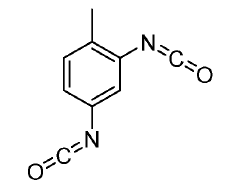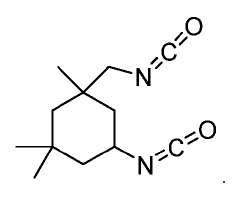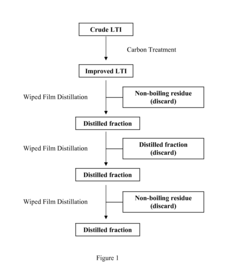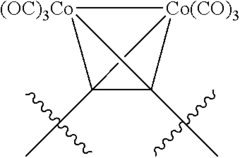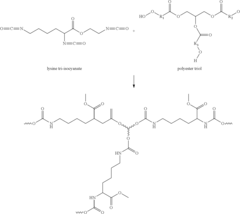Isocyanate Innovations in High-Tech Manufacturing
JUL 10, 20259 MIN READ
Generate Your Research Report Instantly with AI Agent
Patsnap Eureka helps you evaluate technical feasibility & market potential.
Isocyanate Tech Evolution
Isocyanates have undergone significant technological evolution since their discovery in the early 20th century. Initially developed as a byproduct of polyurethane chemistry, these compounds have become integral to various high-tech manufacturing processes. The timeline of isocyanate technology development can be traced through several key phases, each marked by innovative breakthroughs and expanding applications.
In the 1930s, Otto Bayer's groundbreaking work led to the synthesis of polyurethanes, catalyzing the industrial production of isocyanates. This discovery laid the foundation for the widespread use of isocyanates in manufacturing. The 1940s and 1950s saw rapid advancements in isocyanate chemistry, with the development of new formulations and production methods. This period marked the transition of isocyanates from laboratory curiosities to industrial-scale raw materials.
The 1960s and 1970s witnessed a surge in isocyanate applications, particularly in the automotive and construction industries. Innovations in foam technologies and coating systems expanded the versatility of isocyanates, leading to their incorporation in a wide range of products. During this era, significant progress was made in understanding the structure-property relationships of isocyanates, enabling more precise control over their performance characteristics.
The 1980s and 1990s brought about a focus on environmental and health considerations. This period saw the development of low-emission isocyanates and improved handling techniques, addressing concerns about worker safety and environmental impact. Concurrently, advancements in polymer science led to the creation of novel isocyanate-based materials with enhanced properties, such as improved durability and chemical resistance.
The turn of the millennium marked a new phase in isocyanate technology, characterized by a shift towards sustainability and high-performance applications. Bio-based isocyanates emerged as a promising alternative to petroleum-derived variants, aligning with growing environmental consciousness. In parallel, nanotechnology opened new frontiers for isocyanate applications, enabling the development of materials with unprecedented properties at the molecular level.
Recent years have seen a convergence of isocyanate technology with other cutting-edge fields, such as 3D printing and smart materials. Innovations in isocyanate-based resins have facilitated the production of complex, high-precision components for aerospace and medical applications. Additionally, the integration of isocyanates into responsive and self-healing materials represents a frontier in adaptive manufacturing technologies.
Looking ahead, the evolution of isocyanate technology is poised to continue its trajectory of innovation. Emerging trends include the development of ultra-low-VOC formulations, exploration of novel catalytic systems for more efficient reactions, and the creation of isocyanate-based materials with programmable properties. These advancements are expected to further expand the role of isocyanates in high-tech manufacturing, driving progress in sectors ranging from electronics to renewable energy technologies.
In the 1930s, Otto Bayer's groundbreaking work led to the synthesis of polyurethanes, catalyzing the industrial production of isocyanates. This discovery laid the foundation for the widespread use of isocyanates in manufacturing. The 1940s and 1950s saw rapid advancements in isocyanate chemistry, with the development of new formulations and production methods. This period marked the transition of isocyanates from laboratory curiosities to industrial-scale raw materials.
The 1960s and 1970s witnessed a surge in isocyanate applications, particularly in the automotive and construction industries. Innovations in foam technologies and coating systems expanded the versatility of isocyanates, leading to their incorporation in a wide range of products. During this era, significant progress was made in understanding the structure-property relationships of isocyanates, enabling more precise control over their performance characteristics.
The 1980s and 1990s brought about a focus on environmental and health considerations. This period saw the development of low-emission isocyanates and improved handling techniques, addressing concerns about worker safety and environmental impact. Concurrently, advancements in polymer science led to the creation of novel isocyanate-based materials with enhanced properties, such as improved durability and chemical resistance.
The turn of the millennium marked a new phase in isocyanate technology, characterized by a shift towards sustainability and high-performance applications. Bio-based isocyanates emerged as a promising alternative to petroleum-derived variants, aligning with growing environmental consciousness. In parallel, nanotechnology opened new frontiers for isocyanate applications, enabling the development of materials with unprecedented properties at the molecular level.
Recent years have seen a convergence of isocyanate technology with other cutting-edge fields, such as 3D printing and smart materials. Innovations in isocyanate-based resins have facilitated the production of complex, high-precision components for aerospace and medical applications. Additionally, the integration of isocyanates into responsive and self-healing materials represents a frontier in adaptive manufacturing technologies.
Looking ahead, the evolution of isocyanate technology is poised to continue its trajectory of innovation. Emerging trends include the development of ultra-low-VOC formulations, exploration of novel catalytic systems for more efficient reactions, and the creation of isocyanate-based materials with programmable properties. These advancements are expected to further expand the role of isocyanates in high-tech manufacturing, driving progress in sectors ranging from electronics to renewable energy technologies.
Market Demand Analysis
The market demand for isocyanate innovations in high-tech manufacturing has been steadily growing, driven by the increasing need for advanced materials with superior performance characteristics. Isocyanates, known for their versatility and reactivity, play a crucial role in the production of polyurethanes, which find extensive applications in various high-tech industries.
In the automotive sector, there is a rising demand for lightweight materials to improve fuel efficiency and reduce emissions. Isocyanate-based polyurethanes are being increasingly utilized in the manufacturing of interior components, seat cushions, and structural parts. The automotive industry's shift towards electric vehicles has further amplified the need for innovative isocyanate formulations that can enhance battery insulation and thermal management systems.
The electronics industry represents another significant market for isocyanate innovations. With the continuous miniaturization of electronic devices and the growing demand for flexible and wearable technologies, there is a pressing need for advanced materials that can provide excellent insulation, protection, and flexibility. Isocyanate-based coatings and encapsulants are being developed to meet these requirements, offering improved durability and performance for electronic components.
In the aerospace sector, the demand for high-performance materials that can withstand extreme conditions while maintaining lightweight properties is driving the development of innovative isocyanate-based composites. These materials are being used in aircraft interiors, structural components, and insulation systems, contributing to improved fuel efficiency and overall performance of aircraft.
The construction industry is also experiencing a growing demand for isocyanate innovations, particularly in the realm of energy-efficient building materials. Polyurethane foams derived from isocyanates are being increasingly used for insulation purposes, helping to reduce energy consumption in buildings. Additionally, isocyanate-based coatings and adhesives are gaining traction in the construction sector due to their durability and weather resistance properties.
The medical device industry represents another promising market for isocyanate innovations. With the increasing demand for biocompatible materials and advanced wound care products, isocyanate-based polyurethanes are being developed for applications such as medical tubing, prosthetics, and wound dressings. The ability to tailor the properties of these materials to specific medical requirements is driving their adoption in this sector.
As environmental concerns continue to grow, there is a rising demand for sustainable and eco-friendly isocyanate formulations. This has led to the development of bio-based isocyanates and polyurethanes, which are gaining traction in various high-tech manufacturing applications. The market is witnessing a shift towards greener alternatives that can maintain the performance characteristics of traditional isocyanates while reducing environmental impact.
Overall, the market demand for isocyanate innovations in high-tech manufacturing is expected to continue its upward trajectory, driven by the need for advanced materials across multiple industries. The ability of isocyanates to be tailored for specific applications, combined with ongoing research and development efforts, positions them as a key enabler for technological advancements in various high-tech sectors.
In the automotive sector, there is a rising demand for lightweight materials to improve fuel efficiency and reduce emissions. Isocyanate-based polyurethanes are being increasingly utilized in the manufacturing of interior components, seat cushions, and structural parts. The automotive industry's shift towards electric vehicles has further amplified the need for innovative isocyanate formulations that can enhance battery insulation and thermal management systems.
The electronics industry represents another significant market for isocyanate innovations. With the continuous miniaturization of electronic devices and the growing demand for flexible and wearable technologies, there is a pressing need for advanced materials that can provide excellent insulation, protection, and flexibility. Isocyanate-based coatings and encapsulants are being developed to meet these requirements, offering improved durability and performance for electronic components.
In the aerospace sector, the demand for high-performance materials that can withstand extreme conditions while maintaining lightweight properties is driving the development of innovative isocyanate-based composites. These materials are being used in aircraft interiors, structural components, and insulation systems, contributing to improved fuel efficiency and overall performance of aircraft.
The construction industry is also experiencing a growing demand for isocyanate innovations, particularly in the realm of energy-efficient building materials. Polyurethane foams derived from isocyanates are being increasingly used for insulation purposes, helping to reduce energy consumption in buildings. Additionally, isocyanate-based coatings and adhesives are gaining traction in the construction sector due to their durability and weather resistance properties.
The medical device industry represents another promising market for isocyanate innovations. With the increasing demand for biocompatible materials and advanced wound care products, isocyanate-based polyurethanes are being developed for applications such as medical tubing, prosthetics, and wound dressings. The ability to tailor the properties of these materials to specific medical requirements is driving their adoption in this sector.
As environmental concerns continue to grow, there is a rising demand for sustainable and eco-friendly isocyanate formulations. This has led to the development of bio-based isocyanates and polyurethanes, which are gaining traction in various high-tech manufacturing applications. The market is witnessing a shift towards greener alternatives that can maintain the performance characteristics of traditional isocyanates while reducing environmental impact.
Overall, the market demand for isocyanate innovations in high-tech manufacturing is expected to continue its upward trajectory, driven by the need for advanced materials across multiple industries. The ability of isocyanates to be tailored for specific applications, combined with ongoing research and development efforts, positions them as a key enabler for technological advancements in various high-tech sectors.
Current Challenges
The current challenges in isocyanate innovations for high-tech manufacturing are multifaceted and complex. One of the primary obstacles is the ongoing concern regarding the toxicity of isocyanates, particularly during the manufacturing process. Despite significant advancements in safety protocols, the potential health risks associated with exposure to isocyanate compounds continue to pose challenges for workers and environmental compliance.
Another significant challenge lies in the development of more sustainable and eco-friendly isocyanate-based products. As global environmental regulations become increasingly stringent, manufacturers face pressure to reduce the environmental impact of isocyanate production and usage. This includes finding ways to minimize volatile organic compound (VOC) emissions and developing bio-based alternatives to traditional petroleum-derived isocyanates.
The demand for high-performance materials in advanced manufacturing sectors, such as aerospace and automotive industries, presents another challenge. Engineers and researchers are tasked with creating isocyanate formulations that can meet increasingly demanding specifications for strength, durability, and heat resistance while maintaining processability and cost-effectiveness.
Furthermore, the optimization of reaction kinetics and curing processes remains a critical area of focus. Achieving precise control over polymerization reactions is essential for producing consistent, high-quality materials. This challenge is particularly acute in applications requiring rapid curing times or specific material properties, such as in 3D printing or advanced composite manufacturing.
The integration of isocyanate-based materials with emerging technologies also presents unique challenges. For instance, the development of smart materials incorporating isocyanates, such as self-healing polymers or shape-memory materials, requires overcoming complex technical hurdles related to molecular design and material behavior prediction.
Lastly, the global supply chain disruptions and raw material shortages have highlighted the need for more resilient and diversified sourcing strategies for isocyanate precursors. Manufacturers are grappling with the challenge of ensuring a stable supply of key ingredients while also exploring alternative feedstocks to reduce dependency on traditional petrochemical sources.
Another significant challenge lies in the development of more sustainable and eco-friendly isocyanate-based products. As global environmental regulations become increasingly stringent, manufacturers face pressure to reduce the environmental impact of isocyanate production and usage. This includes finding ways to minimize volatile organic compound (VOC) emissions and developing bio-based alternatives to traditional petroleum-derived isocyanates.
The demand for high-performance materials in advanced manufacturing sectors, such as aerospace and automotive industries, presents another challenge. Engineers and researchers are tasked with creating isocyanate formulations that can meet increasingly demanding specifications for strength, durability, and heat resistance while maintaining processability and cost-effectiveness.
Furthermore, the optimization of reaction kinetics and curing processes remains a critical area of focus. Achieving precise control over polymerization reactions is essential for producing consistent, high-quality materials. This challenge is particularly acute in applications requiring rapid curing times or specific material properties, such as in 3D printing or advanced composite manufacturing.
The integration of isocyanate-based materials with emerging technologies also presents unique challenges. For instance, the development of smart materials incorporating isocyanates, such as self-healing polymers or shape-memory materials, requires overcoming complex technical hurdles related to molecular design and material behavior prediction.
Lastly, the global supply chain disruptions and raw material shortages have highlighted the need for more resilient and diversified sourcing strategies for isocyanate precursors. Manufacturers are grappling with the challenge of ensuring a stable supply of key ingredients while also exploring alternative feedstocks to reduce dependency on traditional petrochemical sources.
Existing Solutions
01 Synthesis and production of isocyanates
Various methods and processes for synthesizing and producing isocyanates are described. These include novel catalysts, reaction conditions, and precursor materials to improve yield, purity, and efficiency in isocyanate production.- Synthesis and production of isocyanates: Various methods and processes for synthesizing and producing isocyanates are described. These include novel catalysts, reaction conditions, and precursor materials to improve yield, purity, and efficiency in isocyanate production.
- Applications of isocyanates in polymer chemistry: Isocyanates are widely used in polymer chemistry, particularly in the production of polyurethanes. The patents describe various formulations, reaction conditions, and additives to optimize the properties of isocyanate-based polymers for different applications.
- Isocyanate-based coatings and adhesives: Numerous patents focus on the development of coatings and adhesives using isocyanates. These include formulations for improved durability, weather resistance, and bonding strength in various industrial and consumer applications.
- Isocyanate handling and safety measures: Given the reactive nature of isocyanates, several patents address safety concerns and handling procedures. These include methods for reducing exposure risks, improving storage stability, and developing safer alternatives or modified isocyanates with reduced hazards.
- Isocyanate-free alternatives and substitutes: Some patents explore alternatives to traditional isocyanates, aiming to address environmental and health concerns. These include bio-based substitutes, modified chemistries, and alternative crosslinking systems that can provide similar functionalities to isocyanates in various applications.
02 Applications of isocyanates in polymer chemistry
Isocyanates are widely used in polymer chemistry, particularly in the production of polyurethanes. The patents describe various formulations, curing methods, and applications of isocyanate-based polymers in coatings, adhesives, and foams.Expand Specific Solutions03 Isocyanate-modified compounds and materials
Several patents focus on the modification of existing compounds or materials with isocyanates to impart new properties or functionalities. This includes isocyanate-modified resins, fibers, and other substrates for improved performance in various applications.Expand Specific Solutions04 Handling and safety of isocyanates
Due to the reactive nature of isocyanates, several patents address safety concerns and handling procedures. This includes methods for reducing exposure risks, storage techniques, and safe disposal of isocyanate-containing materials.Expand Specific Solutions05 Isocyanate-free alternatives and substitutes
Some patents explore alternatives to traditional isocyanates or methods to reduce or eliminate their use in certain applications. This includes development of isocyanate-free polymers and coatings with similar properties to isocyanate-based materials.Expand Specific Solutions
Key Industry Players
The isocyanate innovations in high-tech manufacturing sector is in a growth phase, with increasing market size driven by demand in automotive, construction, and electronics industries. The global isocyanate market is projected to reach $40 billion by 2025, growing at a CAGR of 6%. Technologically, the field is advancing rapidly, with major players like BASF, Wanhua Chemical, Covestro, and Dow focusing on developing eco-friendly and high-performance isocyanates. These companies are investing heavily in R&D to improve product efficiency, reduce environmental impact, and expand applications in emerging sectors like 3D printing and renewable energy. The competitive landscape is characterized by strategic partnerships, mergers, and acquisitions to strengthen market positions and drive innovation.
BASF Corp.
Technical Solution: BASF has developed innovative isocyanate-based solutions for high-tech manufacturing, focusing on sustainability and performance. Their approach includes the use of bio-based raw materials to produce isocyanates, reducing the carbon footprint of end products[1]. They have also introduced novel aliphatic isocyanates with improved UV stability and weathering resistance, crucial for outdoor applications in electronics and automotive industries[2]. BASF's water-based polyurethane dispersions, derived from isocyanates, offer excellent adhesion and chemical resistance for coatings in high-tech devices[3]. Additionally, they have pioneered micro-encapsulation techniques using isocyanate chemistry for controlled release applications in smart materials and sensors[4].
Strengths: Wide range of sustainable solutions, strong R&D capabilities, and global market presence. Weaknesses: Higher production costs for bio-based isocyanates, potential regulatory challenges for new chemistries.
Wanhua Chemical Group Co., Ltd.
Technical Solution: Wanhua Chemical has made significant strides in isocyanate innovations for high-tech manufacturing. They have developed a proprietary process for producing ultra-pure methylene diphenyl diisocyanate (MDI) with impurity levels below 10 ppm, crucial for sensitive electronic applications[1]. Their advanced isocyanate-terminated prepolymers offer improved processing and mechanical properties for 3D printing of complex components in aerospace and medical devices[2]. Wanhua has also introduced novel blocked isocyanates that enable one-component, heat-curable systems for precision coating of circuit boards and other electronic components[3]. Furthermore, they have pioneered the use of supercritical CO2 technology in isocyanate production, significantly reducing solvent use and environmental impact[4].
Strengths: Cutting-edge purification technologies, diverse product portfolio, and strong focus on sustainability. Weaknesses: Potential supply chain vulnerabilities due to geographic concentration of production facilities.
Core Isocyanate Patents
Flow chemistry synthesis of isocyanates
PatentWO2021119606A1
Innovation
- A continuous flow process involving the mixing of acyl hydrazides with nitrous acid to form acyl azides, followed by heating in the presence of an organic solvent to produce isocyanates through Curtius rearrangement, offering a safer and more scalable method for isocyanate synthesis.
Isocyanate manufacture
PatentActiveUS20120202961A1
Innovation
- The use of diphosgene (ClCO2CCl3) as a substitute for phosgene, allowing for the production of isocyanates at elevated temperatures, either through a two-reactor system or directly in a one-reactor system with a catalyst, to generate isocyanates like lysine ester triisocyanate (LTI) with high purity by reacting an amine with disphosgene.
Environmental Impact
The environmental impact of isocyanate innovations in high-tech manufacturing is a critical consideration as industries strive for sustainable practices. Isocyanates, widely used in the production of polyurethanes, have traditionally been associated with potential environmental and health risks. However, recent advancements have led to more eco-friendly alternatives and improved manufacturing processes.
One significant development is the creation of bio-based isocyanates derived from renewable resources. These alternatives reduce reliance on petroleum-based raw materials, lowering the carbon footprint of production. Researchers have successfully synthesized isocyanates from plant oils and other biomass sources, offering a more sustainable pathway for polyurethane manufacturing.
Improved production techniques have also contributed to minimizing environmental impact. Closed-loop systems and advanced filtration technologies have been implemented to reduce emissions and prevent the release of harmful substances into the environment. These systems capture and recycle volatile organic compounds (VOCs) and other byproducts, significantly decreasing air and water pollution associated with isocyanate production.
Water-based polyurethane systems have gained traction as an environmentally friendly alternative to solvent-based systems. These formulations reduce VOC emissions and eliminate the need for harmful solvents, making them safer for both workers and the environment. The development of high-performance water-based systems has expanded their application in various high-tech manufacturing sectors.
Advancements in catalyst technology have led to more efficient isocyanate reactions, reducing energy consumption and waste generation. Novel catalysts enable lower reaction temperatures and shorter curing times, resulting in decreased energy requirements and improved overall process efficiency. This not only reduces the environmental footprint but also enhances productivity in manufacturing operations.
The end-of-life management of isocyanate-based products has also seen significant improvements. Innovative recycling and decomposition techniques have been developed to address the challenges of disposing of polyurethane materials. Chemical recycling methods can break down polyurethanes into their constituent components, allowing for the recovery and reuse of valuable raw materials, thus promoting a circular economy approach.
As regulations become more stringent, manufacturers are investing in research to develop isocyanate-free alternatives. While these alternatives are still in various stages of development, they show promise in providing comparable performance characteristics without the associated environmental concerns of traditional isocyanates.
One significant development is the creation of bio-based isocyanates derived from renewable resources. These alternatives reduce reliance on petroleum-based raw materials, lowering the carbon footprint of production. Researchers have successfully synthesized isocyanates from plant oils and other biomass sources, offering a more sustainable pathway for polyurethane manufacturing.
Improved production techniques have also contributed to minimizing environmental impact. Closed-loop systems and advanced filtration technologies have been implemented to reduce emissions and prevent the release of harmful substances into the environment. These systems capture and recycle volatile organic compounds (VOCs) and other byproducts, significantly decreasing air and water pollution associated with isocyanate production.
Water-based polyurethane systems have gained traction as an environmentally friendly alternative to solvent-based systems. These formulations reduce VOC emissions and eliminate the need for harmful solvents, making them safer for both workers and the environment. The development of high-performance water-based systems has expanded their application in various high-tech manufacturing sectors.
Advancements in catalyst technology have led to more efficient isocyanate reactions, reducing energy consumption and waste generation. Novel catalysts enable lower reaction temperatures and shorter curing times, resulting in decreased energy requirements and improved overall process efficiency. This not only reduces the environmental footprint but also enhances productivity in manufacturing operations.
The end-of-life management of isocyanate-based products has also seen significant improvements. Innovative recycling and decomposition techniques have been developed to address the challenges of disposing of polyurethane materials. Chemical recycling methods can break down polyurethanes into their constituent components, allowing for the recovery and reuse of valuable raw materials, thus promoting a circular economy approach.
As regulations become more stringent, manufacturers are investing in research to develop isocyanate-free alternatives. While these alternatives are still in various stages of development, they show promise in providing comparable performance characteristics without the associated environmental concerns of traditional isocyanates.
Safety Regulations
Safety regulations play a crucial role in the implementation of isocyanate innovations in high-tech manufacturing. As these compounds are known for their potential health hazards, stringent safety measures are essential to protect workers and ensure environmental compliance.
The Occupational Safety and Health Administration (OSHA) has established specific standards for isocyanate exposure in the workplace. These regulations mandate permissible exposure limits (PELs) and short-term exposure limits (STELs) for various isocyanates. Manufacturers must adhere to these limits and implement engineering controls, such as ventilation systems and enclosed processes, to minimize worker exposure.
Personal protective equipment (PPE) requirements are another critical aspect of isocyanate safety regulations. Workers handling these compounds must use appropriate respiratory protection, impervious gloves, and protective clothing. Regular medical surveillance and health monitoring programs are also mandated to detect any adverse health effects early.
Environmental regulations, enforced by agencies like the Environmental Protection Agency (EPA), govern the storage, handling, and disposal of isocyanates. These regulations aim to prevent environmental contamination and protect ecosystems from potential harm. Manufacturers must implement proper containment measures, spill response protocols, and waste management practices to comply with these regulations.
Training and education requirements form an integral part of isocyanate safety regulations. Workers must receive comprehensive training on the hazards associated with isocyanates, proper handling procedures, emergency response protocols, and the correct use of PPE. Regular refresher courses are typically required to ensure ongoing compliance and safety awareness.
Risk assessment and management protocols are mandated by safety regulations to identify potential hazards and implement appropriate control measures. This includes conducting regular workplace inspections, maintaining detailed safety data sheets (SDS), and establishing emergency response plans specific to isocyanate-related incidents.
As isocyanate technology advances, safety regulations continue to evolve. Regulatory bodies regularly review and update their standards based on new scientific evidence and emerging best practices. Manufacturers must stay informed about these changes and adapt their safety protocols accordingly to maintain compliance and ensure worker protection.
Compliance with these safety regulations not only protects workers and the environment but also contributes to the overall sustainability and public acceptance of isocyanate innovations in high-tech manufacturing. By prioritizing safety and adhering to these regulations, manufacturers can harness the benefits of isocyanate technology while minimizing associated risks.
The Occupational Safety and Health Administration (OSHA) has established specific standards for isocyanate exposure in the workplace. These regulations mandate permissible exposure limits (PELs) and short-term exposure limits (STELs) for various isocyanates. Manufacturers must adhere to these limits and implement engineering controls, such as ventilation systems and enclosed processes, to minimize worker exposure.
Personal protective equipment (PPE) requirements are another critical aspect of isocyanate safety regulations. Workers handling these compounds must use appropriate respiratory protection, impervious gloves, and protective clothing. Regular medical surveillance and health monitoring programs are also mandated to detect any adverse health effects early.
Environmental regulations, enforced by agencies like the Environmental Protection Agency (EPA), govern the storage, handling, and disposal of isocyanates. These regulations aim to prevent environmental contamination and protect ecosystems from potential harm. Manufacturers must implement proper containment measures, spill response protocols, and waste management practices to comply with these regulations.
Training and education requirements form an integral part of isocyanate safety regulations. Workers must receive comprehensive training on the hazards associated with isocyanates, proper handling procedures, emergency response protocols, and the correct use of PPE. Regular refresher courses are typically required to ensure ongoing compliance and safety awareness.
Risk assessment and management protocols are mandated by safety regulations to identify potential hazards and implement appropriate control measures. This includes conducting regular workplace inspections, maintaining detailed safety data sheets (SDS), and establishing emergency response plans specific to isocyanate-related incidents.
As isocyanate technology advances, safety regulations continue to evolve. Regulatory bodies regularly review and update their standards based on new scientific evidence and emerging best practices. Manufacturers must stay informed about these changes and adapt their safety protocols accordingly to maintain compliance and ensure worker protection.
Compliance with these safety regulations not only protects workers and the environment but also contributes to the overall sustainability and public acceptance of isocyanate innovations in high-tech manufacturing. By prioritizing safety and adhering to these regulations, manufacturers can harness the benefits of isocyanate technology while minimizing associated risks.
Unlock deeper insights with Patsnap Eureka Quick Research — get a full tech report to explore trends and direct your research. Try now!
Generate Your Research Report Instantly with AI Agent
Supercharge your innovation with Patsnap Eureka AI Agent Platform!

